Against a woeful Florida State team (down to 96th in F+!), the only way for Notre Dame to impress both the computers and the CFP committee was to dominate. And while the Irish were slow to get started, they quickly suffocated the Seminoles offense and eventually found enough rhythm of their own to end up with an impressive box score. The early clunkiness from Riley Leonard and the offense dampened the efficiency margin – only being +10% in success was definitely lower than expected. But Notre Dame dominated the explosiveness battle to fuel a massive yards per play advantage (7.4 YPP – 2.9 before garbage time).

Garbage time officially begins in this game with the Irish going up 31-3 in the 3rd quarter, which throws out 26% of plays as garbage even though Notre Dame’s starters stayed in a bit longer. Notably, even with the ND second stringers in the garbage time yards per play margin was extremely similar to the pre-garbage numbers (ND: 7.1 YPP, FSU 3.2).
Al Golden gives offenses early hope, then takes everything away
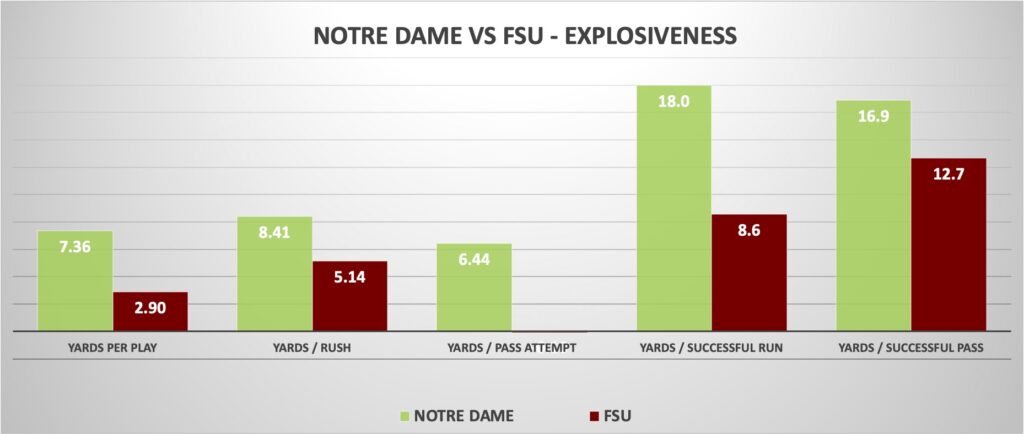
There’s not a ton to dig into when it comes to yet another dominating defensive performance for Al Golden’s unit. Ho hum, another bad offense gets torn to shreds and the passing defense annihilates another bad quarterback. With the pass rush finishing things off consistently, you don’t need to enhance or wipe off your screen on the graph above – FSU was actually in negative yards per dropback before garbage time (-0.1 YPP).
Notre Dame’s pass defense, in a chart https://t.co/7VnjzHqbbM pic.twitter.com/PK805u6dfd
— Greg Flammang (@greg2126) November 13, 2024
Was Florida State’s opening drive fun? Absolutely not! But the pattern of opponent first drives finding success followed by Notre Dame’s defense shutting things down is not a mirage. Opponent first drives have scored 27 points (3.0 points per possession). The other 75 competitive drives? Just 60 points (0.9 points / possession).
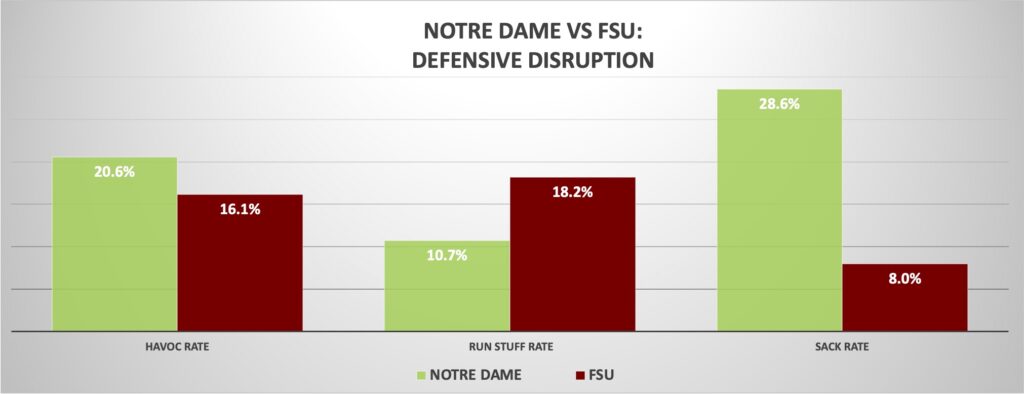
If forced to identify concerns about the defense (up to 4th in Defensive F+), it’s the lack of havoc/disruption and softness in the run game. The havoc wasn’t an issue in this game, taking advantage of a terrible FSU offense and struggling O-Line. But allowing over 5 yards per rush and average efficiency to this Seminoles rushing attack (112th in EPA / rush, 122nd run success rate) isn’t great, even if those runs ultimately weren’t threatening. My bet is that Al Golden could have clamped down more tightly on the run if needed, but it wasn’t needed given the opponent and strength of the passing defense.
Still, I think it’s worth monitoring as Notre Dame fans think ahead to USC or other potential playoff matchups. The pass defense has been outstanding, but the most talented opponent passing attack has been Louisville and Tyler Shough (and #2 is ….a benched Conner Weigman and A&M?). The bulk of the schedule has been hapless offenses, with only the Cardinals (#15 in Offensive F+), A&M (22nd), Georgia Tech (31st but faced ND without Haynes King), and Navy (44th, giving the ball away constantly) able to move the ball on anyone. The other offenses are all outside of the top 90 (!) in FBS – NIU (112th), FSU (115th), Purdue (91st), Miami Ohio (105th), and Stanford (103rd). USC (14th) could pose a solid gut check, but we’ll see where Lincoln Riley’s team is deep in a disappointing season and with Jayden Maiava at QB.
A so-so efficiency game salvaged by explosive offense
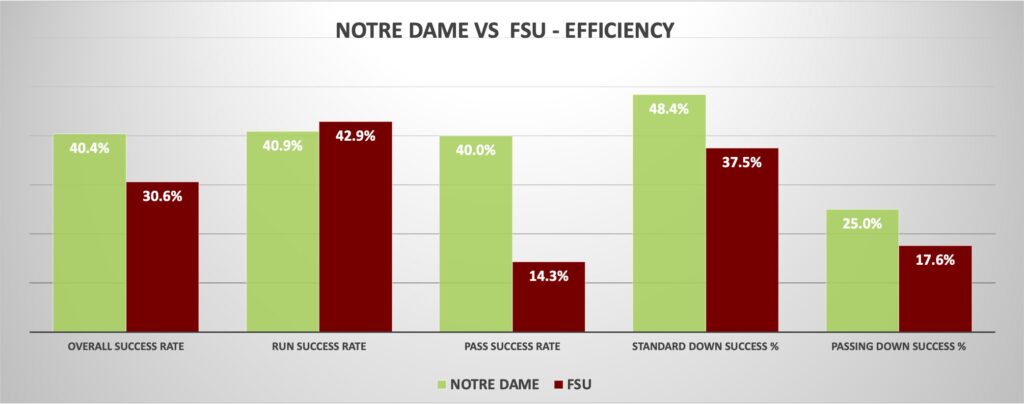
FSU’s defense isn’t quite as miserable as it’s offense. But it’s still 71st in Defensive F+, and you’d like to see an easier first half for the Irish offense consistently moving the ball. Notre Dame’s first six drives resulted in just 14 points, with some quick 3-and-outs after the easy first possession touchdown and others stalling out in FSU territory (including an ugly Mitch Jeter missed FG).
Despite the early inefficiency, on a possession-by-possession basis things look fairly strong thanks to Mike Denbrock and the offense’s explosiveness. The Irish tallied a season-high seven plays of 20+ yards before garbage time, and the most encouraging aspect was five of those were pass plays.
Passing explosiveness has been the untapped ceiling for Riley Leonard and company, and the types of plays attempted and mostly hit on – slot fades, hitting running backs in space, and some timely tunnel screens – feel like Notre Dame’s strengths. Mitchell Evans was at least targeted downfield twice, even if those plays weren’t successful. Back-shoulder attempts to Beaux Collins weren’t successful against FSU corner AZ Thomas, and less reliance on funneling passes his direction feels like a better plan for the offense in preparation for tougher defenses.
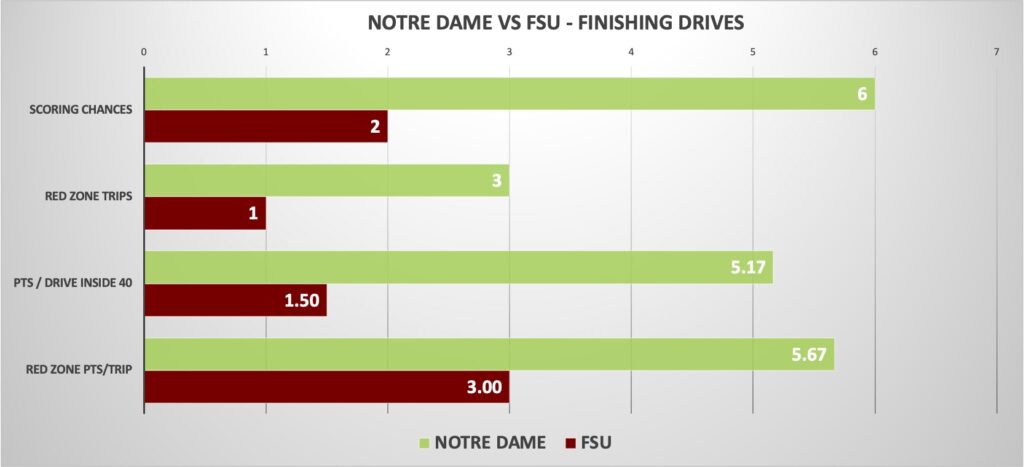
There were some bumps converting scoring chances and settling for field goals, but the season-long numbers continue to be outstanding for Notre Dame. The Irish are in the top-20 on offense and defense in red zone performance, averaging 5.9 points per trip on offense and allowing just 3.6 points per opponent red zone possession. Thank you Mike Norvell for contributing to these numbers with a sad first quarter FG attempt in a game where your team was a 25 point underdog.

The box score sees some luck for Notre Dame finishing +2 in turnovers, but the Irish offense never put the ball in much danger. No fumbles for Notre Dame and the pass breakups included two batted balls at the line of scrimmage and throws where the FSU defender could deflect it but had little chance of a takeaway. Luke Talich’s interception was phenomenal, but most FSU passes (when they could get them away) were short and trying to keep things out of danger. Jordan Clark has been terrific all season and been close to a number of interceptions, so also encouraging to see him finally pick one off.




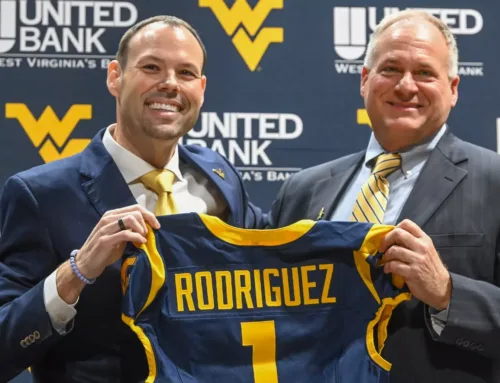
It is amazing what this defense has accomplished this year, especially with the injuries. Al Golden was absolutely the right pick for D-Coordinator when that decision had to be made.
The coaching staff has done a fantastic job this year. Not only the obvious AL Golden, Mike Mickens, and Mike Denbrock, but look how well the O line has Pl Ted, despite all of the injuries. I heard that they are one of 10 semifinalists for the Joe Moore award. Who would have guessed it back in September?
100%, especially the OL performance. Preseason it looked like that was easily the weakest unit and would sink the team. They lost Ashton Craig for the year and Billy Schrauth (probably the two guys we felt most confident in?) for an extended time.
Now you look up at it’s a top-5 rushing game and they’re top-30 in sacks per game (even better with the context that 25% of ND sacks this year came from Steve Angeli in garbage time against Purdue!)
Al Washington is also in a similar category after losing Botelho + Traore very early and then multiple game absences for Rubio, Burnham, Onye. The development and readiness of the 2nd string and beyond forced into bigger roles is massive.
Every year i find myself baffled by how much recognition the OL gets, whether in the Moore award competition, or just by pundits…and then i remember we as ND fans have ridiculously high standards for the OL and no matter how good they are we think theyre having a bad year
And then the OL has a terrible game and Rendell decides to back up my rant from a month ago by dropping bombs…this is totally dogs and cats living together, mass hysteria territory